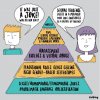How does men’s participation in the social movement to prevent violence against women change their relationships with other men and with women? How does it affect their understanding and practices of masculinity?
Michael Flood
There are at least four forms of evidence we can use to test if pornography increases the likelihood of sexual violence:
In this XY collection, we present podcasts focused on men and masculinities. Thank you to William McInerney, University of Cambridge, for compiling many of these.
What role do men have in the work of challenging gender inequalities and building gender justice? This chapter examines the experiences of men as deliberate agents of a feminist masculinity politics, exploring key challenges in men’s efforts to take up profeminism. This first challenge is overcoming one’s own sexist and violence-supportive attitudes and behaviours. Men may be disinterested in or resistant to efforts to involve them in progressive change because of widespread sexist and violence-supportive attitudes and relations.
Patterns and inequalities of gender make a difference to pandemics. Gender relations and gender inequalities can shape the progression of pandemics, patterns of men’s and women’s responses to them, and pandemics’ impact. In the following, we have collected commentaries on the COVID-19 pandemic and gender. Additions are welcome.
Men’s rights advocates (MRAs) often argue that feminism portrays women as always and ever oppressed, and thus *makes* women into victims. Related to this, MRAs argue that feminist beliefs are harmful for women themselves. However, the actual evidence is that having feminist beliefs and/or a feminist identity is good for women, and that having feminist beliefs or a feminist identity has a range of positive benefits.
Men’s responses to #MeToo, and other forms of feminist advocacy on rape and sexual harassment, range from enthusiastic support to hostile backlash. There are common forms of resistance among men to these campaigns, including defensive denials that men’s violence is routine, a focus on ‘other’ men, and complaints that #MeToo has ‘gone too far’. And for many men, there is simply mute discomfort. Masculinity is implicated directly in men’s perpetration of rape and sexual harassment, but also in men’s widespread inaction or complicity in the face of men’s violence against women.
Pornography has become the default sex educator for large numbers of young people. Viewing pornography is routine, especially among boys and young men, as two Australian studies document. Children and young people are encountering pornography in greater numbers, at younger ages, and with a wider variety of content.
Sexist jokes often are dismissed or excused as harmless fun. Yet they have real, negative effects in the world. They are linked to sexist and violent behaviour, they worsen gender inequalities, and they increase tolerance for violence against women.

